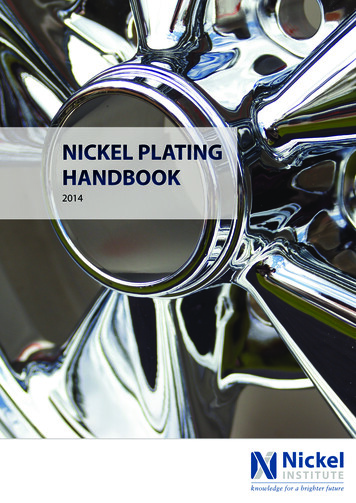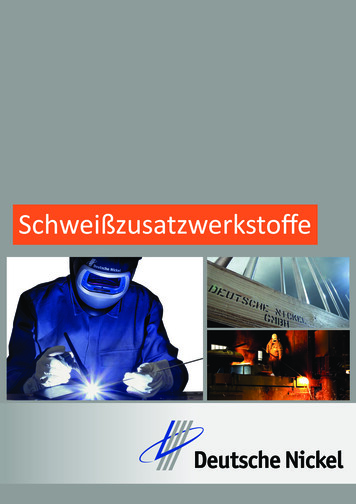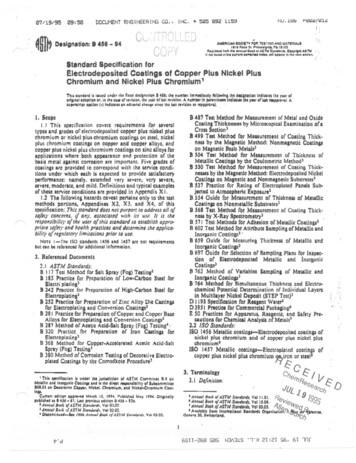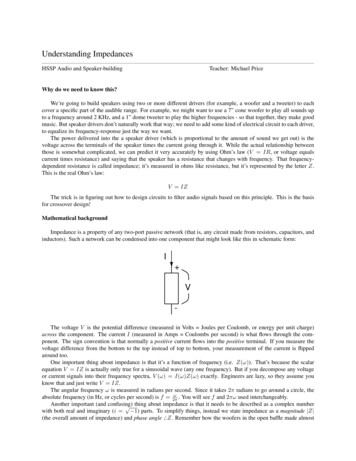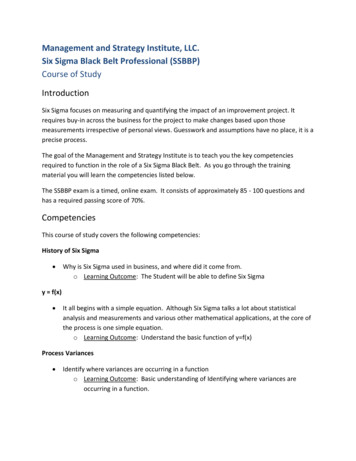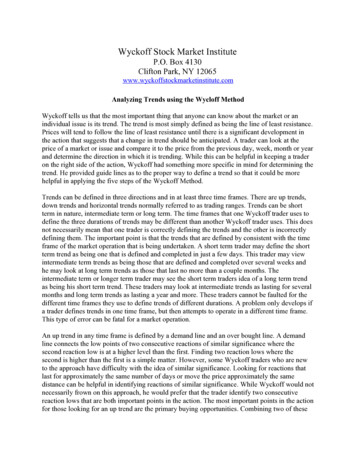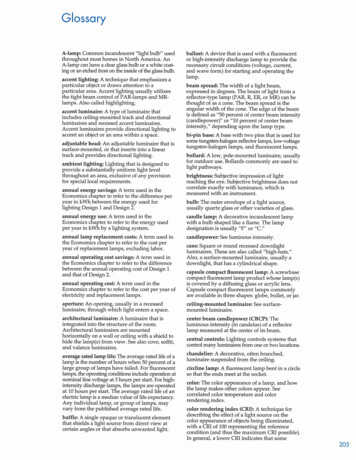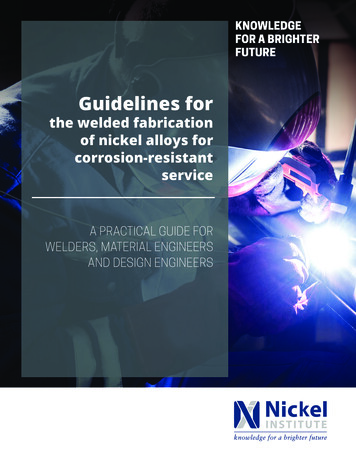
Transcription
KNOWLEDGEFOR A BRIGHTERFUTUREGuidelines forthe welded fabricationof nickel alloys forcorrosion-resistantserviceA PRACTICAL GUIDE FORWELDERS, MATERIAL ENGINEERSAND DESIGN ENGINEERS
2Guidelines forthe welded fabricationof nickel alloys forcorrosion-resistant serviceA PRACTICAL GUIDESecond EditionPublished 2018The material presented in this publication has been preparedfor the general information of the reader and should not beused or relied on for specific applications without first securingcompetent advice.The Nickel Institute, its members, staff and consultants do notrepresent or warrant its suitability for any general or specificuse and assume no liability or responsibility of any kind inconnection with the information herein.This report was prepared by:Richard E. AveryConsultant to the Nickel Institute.Technical Editor: Geir MoeGuidelines for the welded fabrication of nickel alloys for corrosion-resistant service
3ContentsIntroduction . . . . . . . . . . . . . . . . . . . . . . . . . . . . . . . . . . . . 7PART I – For the welder . . . . . . . . . . . . . . . . . . . . . . . . . . . 9Physical properties of nickel alloys . . . . . . . . . . . . . . . . . . 9Corrosion resistance of nickel alloy welds . . . . . . . . . . . . 9Welding qualifications . . . . . . . . . . . . . . . . . . . . . . . . . . . . 11Welding procedure specification . . . . . . . . . . . . . . . . . 11Welder performance qualification and training . . . . 12Weld joint design . . . . . . . . . . . . . . . . . . . . . . . . . . . . . . . . 12Preparation for welding . . . . . . . . . . . . . . . . . . . . . . . . . . . 13Welding processes . . . . . . . . . . . . . . . . . . . . . . . . . . . . . . . 17PART III – For the design engineer . . . . . . . . . . . . . . . . 39Design for corrosion service . . . . . . . . . . . . . . . . . . . . . . . 39Weld overlay, sheet lining, and clad plate . . . . . . . . . . . 43Weld overlay . . . . . . . . . . . . . . . . . . . . . . . . . . . . . . . . . . 44SAW; GMAW; SMAW; Weld overlay guidelinesSheet lining . . . . . . . . . . . . . . . . . . . . . . . . . . . . . . . . . . . 45Clad plate . . . . . . . . . . . . . . . . . . . . . . . . . . . . . . . . . . . . . 45Safety and welding fumes . . . . . . . . . . . . . . . . . . . . . . . 49Shielded metal arc welding (SMAW) . . . . . . . . . . . . . . 17Gas tungsten arc welding (GTAW) . . . . . . . . . . . . . . . . 19Reference documents . . . . . . . . . . . . . . . . . . . . . . . . . . . 51Gas metal arc welding (GMAW) . . . . . . . . . . . . . . . . . . 22Flux cored arc welding (FCAW) . . . . . . . . . . . . . . . . . . . 23Submerged arc welding (SAW) . . . . . . . . . . . . . . . . . . . 23Other welding processes . . . . . . . . . . . . . . . . . . . . . . . . 24Welding nickel alloy pipe . . . . . . . . . . . . . . . . . . . . . . . . . . 24Post-fabrication cleaning . . . . . . . . . . . . . . . . . . . . . . . . . .27PART II – For the materials engineer . . . . . . . . . . . . . . 29General guidelines for nickel alloys . . . . . . . . . . . . . . . . . . 29Group I - Nickel and nickel-copper alloys . . . . . . . . . . . . 30Group II - Chromium-bearing alloys . . . . . . . . . . . . . . . . 31Group III - Nickel-molybdenum alloys . . . . . . . . . . . . . . . 31Group IV - Precipitation-hardening nickel alloys . . . . . . 32Dissimilar-metal welds . . . . . . . . . . . . . . . . . . . . . . . . . . . . 32Procurement guidelines . . . . . . . . . . . . . . . . . . . . . . . . . . 33Nickel alloy castings . . . . . . . . . . . . . . . . . . . . . . . . . . . . . . 33Source Inspections . . . . . . . . . . . . . . . . . . . . . . . . . . . . . 35 radiographic inspection; liquid penetrant inspection;weldability test; pressure test; certification; heattreatment; chemistryCasting repair by welding . . . . . . . . . . . . . . . . . . . . . . . 37Welding nickel alloy castings . . . . . . . . . . . . . . . . . . . . . 37Procurement checklist for nickel alloy castings . . . . . 38Contents
4TablesTable 1Wrought nickel alloys by group . . . . . . . . . . . . 9Table 2I nfluence of physical propertieson welding nickel alloys . . . . . . . . . . . . . . . . . . 10Table 3Nickel alloy cutting methods . . . . . . . . . . . . . . 14Table 4Embrittling elements . . . . . . . . . . . . . . . . . . . . 14Table 5 atching composition filler metalsMfor nickel alloys . . . . . . . . . . . . . . . . . . . . . . . . . 18Table 6 Comparison of GMAW arc modesfor nickel alloys . . . . . . . . . . . . . . . . . . . . . . . . . 23Table 7 ominal composition of significantNelements of Groups I–IV wroughtnickel and nickel alloys . . . . . . . . . . . . . . . . . . . 30Table 8 Nominal composition of castcorrosion resistant nickel alloys . . . . . . . . . . . 31Table 9 atching filler metals of theMcomparable solid solution alloys . . . . . . . . . . 32Table 10-A F iller metal alloy identification forbare and covered electrodes . . . . . . . . . . . . . 33Table 10-B S uggested filler metals fordissimilar metal welds . . . . . . . . . . . . . . . . . . . 34Table 11 pecifications for procurementSof wrought nickel and nickel alloys . . . . . . . . 35Table 12 Comparisons of weld overlay,sheet lining, and clad plate . . . . . . . . . . . . . . . 44Guidelines for the welded fabrication of nickel alloys for corrosion-resistant service
5FiguresFigure 1Incomplete fusion in pipe rootpass weld . . . . . . . . . . . . . . . . . . . . . . . . . . . . . . 10Figure 25 Corner weld from inside—poor inside, worst outside . . . . . . . . . . . . . . 40Figure 2-1 Typical joint designs forto 2-5sheet and plate . . . . . . . . . . . . . . . . . . . . . . 12,13Figure 26 Corner weld from both sides—poor inside, good outside . . . . . . . . . . . . . . 40Figure 3 Sample showing sulphurembrittlement of a Nickel 200 sheet . . . . . . . 15Figure 27 Side wall in lieu of corner weld—best inside, good outside,fatigue resistant . . . . . . . . . . . . . . . . . . . . . . . . . 40Figure 4 Typical backing bar designs for usewith and without a backing gas . . . . . . . . . . . 16Figure 5 Tack weld sequence to provideuniform weld gap . . . . . . . . . . . . . . . . . . . . . . . 17Figure 28 Tray support, staggeredstrength weld—severe crevice . . . . . . . . . . . . 41The arc zone in the SMAW process . . . . . . . . 17Figure 29 Tray support, full seal weld top—good crevice resistance . . . . . . . . . . . . . . . . 41Figure 7 The Gas Tungsten Arc Weld (GTAW)process . . . . . . . . . . . . . . . . . . . . . . . . . . . . . . . . 20Figure 30 Tray support, full seal weld top &bottom—best crevice resistance . . . . . . . . . . 41Figure 8 The basic components of theGas Metal Arc Weld (GMAW) process . . . . . . 22Figure 31 Reinforcing pad, staggered welds—adequate strength . . . . . . . . . . . . . . . . . . . . 41Figure 9 Typical joint design for pipe withconsumable insert . . . . . . . . . . . . . . . . . . . . . . 25Figure 32 Reinforcing pad, seal weld—best crevice resistance . . . . . . . . . . . . . . . . . 41Figure 10 Typical joint design for pipe welded withopen root joint and hand-fed filler metal . . . 25Figure 33Position of angles . . . . . . . . . . . . . . . . . . . . . . . 41Figure 34Position of angles . . . . . . . . . . . . . . . . . . . . . . . 41Figure 11 Standard consumable insert shapes,ANSI/AWS D10.11 . . . . . . . . . . . . . . . . . . . . . . . 26Figure 35Position of channels . . . . . . . . . . . . . . . . . . . . . 41Figure 36Stiffeners and baffles . . . . . . . . . . . . . . . . . . . . 42Figure 12Typical pipe purging fixtures . . . . . . . . . . . . . . 26Figure 37Corner baffle cut-out—good . . . . . . . . . . . . . . 42Figure 13Flat bottom, square corners—worst . . . . . . . 39Figure 38Heat exchanger, baffle cut-out—good . . . . . . . . . . . . . . . . . . . . . . . . . . . . . . . . 42Figure 6Figure 14 Flat bottom, rounded corners—good corners—poor outside . . . . . . . . . . . 39Figure 15 Flat bottom, rounded corners, grouted—good inside, poor outside . . . . . . . . . . . . . . 39Figure 16 Flat bottom, rounded corners, drip skirt—good inside, good outside . . . . . . . . . . . . . . 39Figure 17 Concave bottom rounded corners—goodinside, good outside, fatigue resistant . . . . . .39Figure 18 Dished head—best inside, best outside,fatigue resistant . . . . . . . . . . . . . . . . . . . . . . . . . 39Figure 19Side outlet above bottom—poor . . . . . . . . . . 40Figure 20Centre outlet, above bottom—poor . . . . . . . 40Figure 21Side outlet, flush—good . . . . . . . . . . . . . . . . . .40Figure 22Centre outlet recessed—good . . . . . . . . . . . . 40Figure 23Side outlet, flush, sloped—best . . . . . . . . . . . 40Figure 24Centre outlet, recessed, sloped—best . . . . . 40Figure 39 Poor and good designs forthe location of heaters in a vessel . . . . . . . . . 42Figure 40 Poor and good designs for mixingconcentrated and dilute solutions . . . . . . . . . 42Figure 41 Pipe weld with incomplete penetration—severe crevice . . . . . . . . . . . . . . . . . . . . . . . . 43Figure 42 ipe recessed, flange and pipe,Psame alloy— good . . . . . . . . . . . . . . . . . . . . . . 43Figure 43 ipe flush, pipe and flangePsame alloy—better . . . . . . . . . . . . . . . . . . . . . . 43Figure 44 tub–end, flange carbon steel orSductile iron—very good . . . . . . . . . . . . . . . . . . 43Figure 45(A) Horizontal (standard)—poor . . . . . . . . . . . 43(B) Sloped)—very good . . . . . . . . . . . . . . . . . . . 43Figure 46Weld joints for liners . . . . . . . . . . . . . . . . . . . . . 46Figure 47Joint designs for clad steel . . . . . . . . . . . . . . . . 46Contents
6Guidelines for the welded fabrication of nickel alloys for corrosion-resistant service
7IntroductionThis publication is presented in three parts with each, inturn, focused toward the primary interests of the welder, thematerials engineer, and the design engineer.Part I, FOR THE WELDER, assumes that the welders and othersinvolved in welded fabrication are familiar with the basictechniques used in carbon steel fabrication and have hadlimited experience with nickel alloys. The discussion treatsmany areas of concern to the welder and gives practicalsuggestions concerning the effects of shop practices inmaintaining the corrosion resisting properties of the nickelalloys. The importance of proper storage and protection of thesurfaces, proper cleaning combined with the proper cleaningmaterials is stressed both before and after welding. Weldingand welding training and qualification are discussed as wellas arc management during the welding process. A number ofcommonly used welding processes are covered to furnish aperspective of the particular features that ensure improvedresults. Finally, the particular considerations involved inwelding pipe are discussed. Part I takes a “how to” approachuseful to the non-engineer but the material covered is also agood reference for the materials and design engineer.Part III, FOR THE DESIGN ENGINEER, provides a number ofdesign examples showing how the corrosion performance ofnickel alloys used in process tanks can be enhanced throughthoughtful design. A generous number of figures illustrate theconfigurations which improve the prospects for successfulperformance in corrosive environments. The discussion alsotreats weld overlay, sheet lining, and clad plate as alternativemeans of providing corrosion protection using nickel alloys.A number of welding processes are briefly evaluated astools for achieving the desired results with each of thesealternates.Part II, FOR THE MATERIALS ENGINEER, describes the typesof nickel alloys; it reviews how their metallurgical andcorrosion characteristics are affected by welding and coverssome of the more specialised aspects of fabrication such asheat treating. A number of useful references are included toassist in the selection of electrodes, rods, and filler metalsfor solid solution alloys. Additional tables cover the selectionof electrodes and rods for dissimilar metal welds. Guidelinesare included for material procurement of castings alongwith suggestions for supplementing the specifications withadditional requirements and tests to assure the quality of thefinished castings.Introduction
8Guidelines for t
4 Guidelines for the welded fabrication of nickel alloys for corrosion-resistant service Tables Table 1 Wrought nickel alloys by group . . . . . . . . . . . . .9
